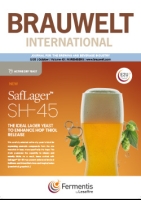When March rolled around, it was once again time for the Brewing Science Seminar in Wuhan, China. This year, the third annual seminar took place from the March 11th to 14th, 2013, and the motto selected for the event held was “Energy Issues at the Center of Science and Innovation”. The seminar is jointly organized by the Technical Brewing Academy in Wuhan and publishing house Hans Carl of Nuremberg, who issues the Chinese edition of BRAUWELT.
Very heavy rainfall on June 2nd and 3rd caused flooding in many Bavarian hop gardens. First
GrainCorp Malt, the parent company of German maltster Schill Malz and the UK maltster Bairds Malt has announced that it will implement a reorganization of its European businesses. This reorganization will allow the German and UK businesses to provide better service and capabilities to their customers as they will benefit from closer cooperation in all divisions - in manufacturing, engineering and sales.
In 2010 the company Wolf Anlagen-Technik GmbH & Co. KG (Geisenfeld) and the VLB Berlin e.V. started a two year project focusing on energy recovery during hop kilning. A heat exchanger was installed in an industrial scale hop kiln in order to decrease the consumption of primary energy. The efficiency of heat recovery using exhaust air of the hop kilning process was determined and potentially saved primary energy calculated. Heat recovery from exhaust air produces certain volumes of condensate. The collected condensate was analysed for eight selected hop oil components which were also determined in green and kilned hops. Before the heat exchange process the exhaust air was forced through a filter cartridge that contained activated carbon material..
Since recent years plastic packaging material is used for draft beer in disposable kegs. Week points of disposable kegs are the barrier properties and the mechanical properties of the packaging material.
CDC PolarStar was successfully developed as the first lipoxygenase-1-less (LOX-less) malting barley variety in North America by successive backcross and molecular marker assisted selection (MMAS). The yield potential, the agronomic performance and the general malting quality of CDC PolarStar were equivalent to those of the recurrent parent CDC Kendall which was one of well evaluated and accepted two-rowed malting barley varieties in North America. These are very important findings to demonstrate that the LOX-less trait could be used for barley breeding to improve beer quality without affecting such characteristics. To evaluate effects of LOX-less trait on beer quality, several brewing trials were conducted at the pilot and the commercial scale facilities..
As dry hopping shows increasing importance, we are extensively investigating its influence on aroma and bitterness. At the same time we have to be aware of hops as a nitrate storing plant. In the cone concentrations of nitrate can be found up to more than 1000 mg per 100 g of hops.
In general, hops are classified either as aroma hops or bitter hops/high alpha hops. Aroma hops contain relatively small amounts of alpha acids and are mainly used for flavouring beer. Bitter hops/high alpha hops contain large amounts of alpha acids and are mainly used for bittering beer. In recent times, new types of aroma hops have been bred. These hops impart very characteristic fruity flavours, for example citrus, tropical fruit etc., to finished beer and contain large amounts of alpha acids. Such hop types are thus oftentimes referred to as dual-purpose hops. However, key flavour compounds contributing to such flavours have not yet been sufficiently investigated. This report focuses on several specific flavour compounds and their contribution to flavours of new aroma hop cultivars.
Sustainability evaluations are steadily increasing in the brewing industry, particularly with regard to the raw material used in the greatest quantity for brewing beer, namely water. Water consumption is rising worldwide and has the potential for threatening reliable supplies of clean water [1]. Water consumption in beer production begins with the cultivation and processing of the raw materials. The concept of a water footprint attempts to identify all of water flows used during the life cycle of a product or service, so that the total quantity of water can be calculated. When the water footprint is taken into account, the quantity of water used in the production of one hectoliter of beer is much higher than the three to six hectoliters typically cited in the literature [2, 3].
From May 22 to 25 2013, the 12th international forum “Beer 2013” and the 20th international beverage exhibition “Wine & Vodka. World of Water 2013” take place in the exhibition center of Zhemchuzhina hotel in Sochi, Russia. The event is organized by CJSC “SOUD–Sochi Exhibitions”.
For the prediction of the beer’s flavour stability, the determination of the so-called lag-time using electron spin resonance spectroscopy (ESR) has become a standardized method. Previous investigations demonstrated that the lagtime measurement used up to now distorts the results of oxidative flavour stability due to an increasing pH value during the analysis caused by the spin trap reagent (PBN). Against this background, a new EAP determination was developed which excludes the distortions and provides a new index number for the evaluation of flavour stability; the Beverage Antioxidative indeX (BAX). The results could be used to describe the positive effect and mechanisms of α-acids and low pH-values on the oxidative beer stability..



